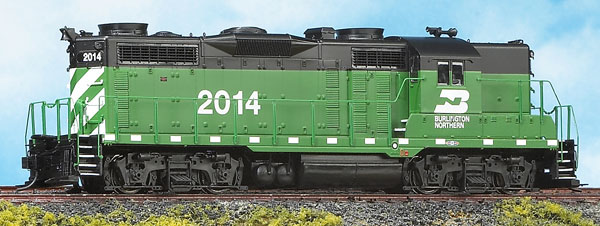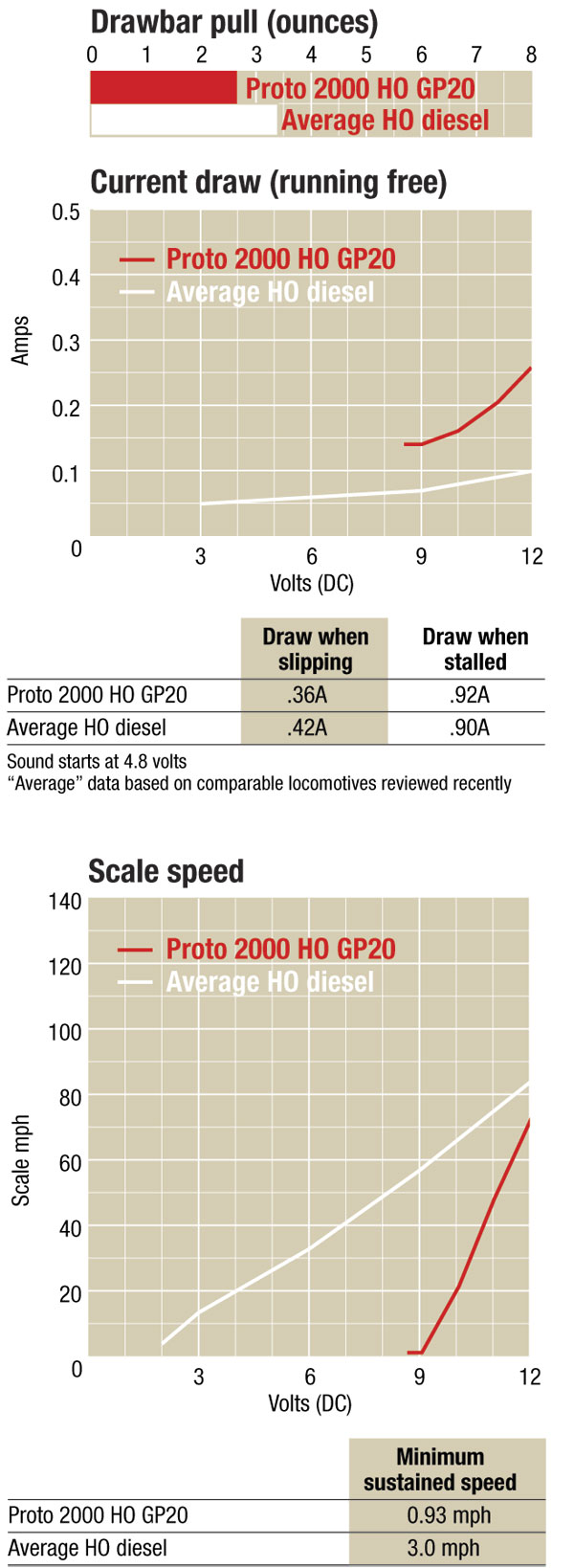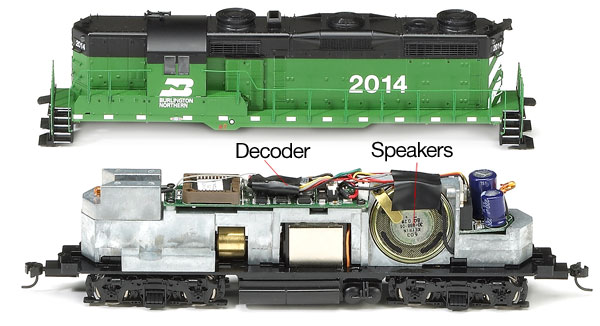Though production of the GP20 began in 1959, the history of this four-axle road switcher can be traced back to an experiment in September 1955. It was then that the Union Pacific shop forces in Omaha, Neb., installed turbochargers in 19 of the railroad’s GP9s (later dubbed “Omaha GP20s”). The conversion work was successful in increasing the horsepower rating of the engines.
In 1959, EMD released its own turbocharger and tested it on nine UP GP9s between March and June. The turbochargers proved feasible, and the first EMD-built GP20 rolled off the assembly line in November 1959. By the end of the production run in April 1962, another 259 units were built. While most of the GP20s had low noses, 46 units (36 for Great Northern and 10 for Western Pacific) sported high noses.
The GP20 is powered by a five-pole skew-wound motor that’s recessed into the die-cast metal chassis. The printed-circuit (PC) board is screw-mounted to the weight, and the speakers are mounted A-frame style near the rear of the locomotive.
The axles are driven by worm and spur gears enclosed in the gear¬boxes. Correctly gauged RP-25 wheels are mounted on split axles, allowing all drivers to pick up electrical current. The acetal plastic sideframes are well detailed with separate brake cylinders.
Some old, much new. In 1998, Life-Like released a low-nose GP20 and reissued it with DCC and sound in early 2005. Walthers, which acquired Life-Like in July 2005, reused the long hood from the low-nose GP20 but tooled many new parts for its high-nose model, including the frame, battery boxes, steps, and fuel tanks (small with rear-mount air reservoirs for Burlington Northern and Great Northern, large with top-mount air reservoirs for Western Pacific and Union Pacific). The body shells are four-piece assemblies with a separate cab, short and long hood, and frame.
Our sample is decorated for Burlington Northern and features evenly applied paint, crisp color-separation lines, and opaque white lettering and striping. The bell is properly mounted on the long hood to match BN’s (and predecessor Great Northern’s) practice of operating GP20s long-hood forward. The white trim on the step edges was a nice touch, but I was surprised that the vertical handrails didn’t have white paint to match the prototype.
Prototype plans for the GP20 were published in the Model Railroader Cyclopedia: Vol. 2, Diesel Locomotives. The Walthers model closely matches the dimensions in those drawings.
I was able to activate a limited number of sound effects in DC operation, including the engine rumble, horn, and bell. However, a broader range of sounds can be activated on DC layouts with the Life-Like Proto Quantum Engineer (Walthers item no. 920-5990).
The GP20 also performed well on our DCC test track, achieving a top speed of 91 scale mph at step 28. This was just 2 mph faster than the prototype’s top speed. The sound was loud out of the box, but I was able to adjust it with the supplied magnetic wand. The volume can also be adjusted using DCC programming.
As with most DCC and sound-equipped locomotives, there’s a weight trade-off to fit all the electronics inside. The GP20 has a drawbar pull of 2.72 ounces, equivalent to 38 free-rolling freight cars on straight and level track.
Impressive. This high-nose GP20 from Walthers is impressive with its railroad-specific details and smooth-running mechanism.
Only 46 high-nose GP20s were built, and they ran mostly in the West. Whether you’re a fan of one of the railroads that operated the high-nose GP20 or just like four-axle Geeps, you’ll want to add one of these models to your roster.
Price: GP20 with dual-mode DCC and QSI Quantum sound system $225; DC-only versions, $125
Manufacturer
Wm. K. Walthers, Inc.
P.O. Box 3039
Milwaukee, WI 53201
www.walthers.com
Description: Plastic and metal, ready-to-run, high-nose diesel locomotive
Road names (two road numbers each in DC and DCC): Burlington Northern (green and black or Big Sky Blue), Great Northern (Big Sky Blue or Omaha Orange and Pullman Green), Union Pacific, Western Pacific (green with orange stripes or silver and orange), and undecorated
Acetal plastic handrails
Die-cast metal chassis
Directional, light-emitting-diode headlights
Drawbar pull: 2.72 ounces
Dual-mode sound decoder operates on both DC and DCC layouts
Five-pole skew-wound motor
Proto 2000 magnetic knuckle couplers
Minimum radius: 18″
Railroad-specific details with factory-applied eye bolts, grab irons, and m.u. hoses
See-through fans
Unpainted crew in cab
Weight: 14.5 ounces
Window glazing















